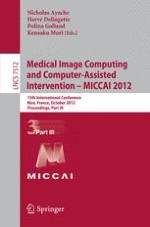The three-volume set LNCS 7510, 7511, and 7512 constitutes the refereed proceedings of the 15th International Conference on Medical Image Computing and Computer-Assisted Intervention, MICCAI 2012, held in Nice, France, in October 2012. Based on rigorous peer reviews, the program committee carefully selected 252 revised papers from 781 submissions for presentation in three volumes. The third volume includes 79 papers organized in topical sections on diffusion imaging: from acquisition to tractography; image acquisition, segmentation and recognition; image registration; neuroimage analysis; analysis of microscopic and optical images; image segmentation; diffusion weighted imaging; computer-aided diagnosis and planning; and microscopic image analysis.
